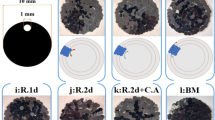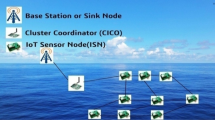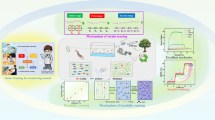Abstract
Underwater surface electromyography (sEMG) signals are especially of interest for rehabilitation and sports medicine applications. Silver/silver chloride (Ag/AgCl) hydrogel electrodes, although the gold standard for sEMG data collection, require waterproofing for underwater applications. Having to apply waterproof tape over electrodes impedes the deployment of sEMG in immersed conditions. As a better alternative for underwater applications, we have developed carbon black/polydimethylsiloxane (CB/PDMS) electrodes for collecting sEMG signals under water. We recruited twenty subjects to collect simultaneous recordings of sEMG signals using Ag/AgCl and CB/PDMS electrodes on biceps brachii, triceps brachii, and tibial anterior muscles. The Ag/AgCL electrodes were covered in waterproof tape, and the CB/PDMS electrodes were not. We found no differences in sEMG signal amplitudes between both sensors, for the three muscles. Moderate mean correlation between Ag/AgCl and CB/PDMS electrodes was found on the linear envelopes (≥ 0.7); correlation was higher for power spectral densities (≥ 0.84). Ag/AgCl electrodes performed better in response to noise, whilst the CB/PDMS electrodes were more sensitive to myoelectric activity in triceps and tibialis, and exhibited better response to motion artifacts in the measurements on the triceps and tibialis. Results suggest that sEMG signal collection is possible under water using CB/PDMS electrodes without requiring any waterproof or adhesive tape.






Similar content being viewed by others
References
Arvidsson, A., A. Grassino, and L. Lindström. Automatic selection of uncontaminated electromyogram as applied to respiratory muscle fatigue. J. Appl. Physiol. 56:568–575, 1984.
Benfield, R. D., E. R. Newton, and T. Hortobágyi. Waterproofing EMG instrumentation. Biol. Res. Nurs. 8:195–201, 2007.
Burden, A., and R. Bartlett. Normalisation of EMG amplitude: an evaluation and comparison of old and new methods. Med. Eng. Phys. 21:247–257, 1999.
Caty, V., Y. Aujouannet, F. Hintzy, M. Bonifazi, J. P. Clarys, and A. H. Rouard. Wrist stabilisation and forearm muscle coactivation during freestyle swimming. J. Electromyogr. Kinesiol. Off. J. Int. Soc. Electrophysiol. Kinesiol. 17:285–291, 2007.
Chan, A. D., and G. C. Green. Myoelectric control development toolbox. CMBES Proceedings, 2007
Chevutschi, A., G. Lensel, D. Vaast, and A. Thevenon. An electromyographic study of human gait both in water and on dry ground. J. Physiol. Anthropol. 26:467–473, 2007.
Chi, Y. M., T.-P. Jung, and G. Cauwenberghs. Dry-contact and noncontact biopotential electrodes: methodological review. IEEE Rev. Biomed. Eng. 3:106–119, 2010.
Clarys, J. P. The brussels swimming EMG project. Swim. Sci. V:157–172, 1988.
Clarys, J. P., C. Massez, M. Van Den Broeck, G. Piette, and R. Robeaux. Total telemetric surface of the front crawl. Biomech. VIII-B Int. Ser. Biomech. 4:951–958, 1983.
Clarys, J. P., and A. H. Rouard. The frontcrawl downsweep: shoulder protection and/or performance inhibition. J. Sports Med. Phys. Fitness 36:121–126, 1996.
Dalla Pria Bankoff, A., and M. Vitti. Simultaneous EMG of latissimus dorsi and sternocostal part of pectoralis major muscles during crawl stroke. Electromyogr. Clin. Neurophysiol. 18:289–295, 1978.
De Luca, C. J. The use of surface electromyography in biomechanics. J. Appl. Biomech. 13:135–163, 1997.
Dietz, V., G. A. Horstmann, M. Trippel, and A. Gollhofer. Human postural reflexes and gravity—an under water simulation. Neurosci. Lett. 106:350–355, 1989.
Drost, G., D. F. Stegeman, B. G. M. van Engelen, and M. J. Zwarts. Clinical applications of high-density surface EMG: a systematic review. J. Electromyogr. Kinesiol. 16:586–602, 2006.
Fujisawa, H., N. Suenaga, and A. Minami. Electromyographic study during isometric exercise of the shoulder in head-out water immersion. J. Shoulder Elbow Surg. 7:491–494, 1998.
Gibbons, J. D., and S. Chakraborti. Nonparametric statistical inference. In: International Encyclopedia of Statistical Science, edited by M. Lovric. New York: Springer, 2011, pp. 977–979.
Hermens, H. J., B. Freriks, R. Merletti, D. Stegeman, J. Blok, G. Rau, C. Disselhorst-Klug, and G. Hägg. European recommendations for surface electromyography. Roessingh Res. Dev. 8:13–54, 1999.
Hodges, P. W., and B. H. Bui. A comparison of computer-based methods for the determination of onset of muscle contraction using electromyography. Electroencephalogr. Clin. Neurophysiol. 101:511–519, 1996.
Jung, H.-C., J.-H. Moon, D.-H. Baek, J.-H. Lee, Y.-Y. Choi, J.-S. Hong, and S.-H. Lee. CNT/PDMS composite flexible dry electrodes for long-term ECG monitoring. IEEE Trans. Biomed. Eng. 59:1472–1479, 2012.
Kaneda, K., H. Wakabayashi, D. Sato, and T. Nomura. Lower extremity muscle activity during different types and speeds of underwater movement. J. Physiol. Anthropol. 26:197–200, 2007.
Kelly, B. T., L. A. Roskin, D. T. Kirkendall, and K. P. Speer. Shoulder muscle activation during aquatic and dry land exercises in nonimpaired subjects. J. Orthop. Sports Phys. Ther. 30:204–210, 2000.
Koryak, Y. Electrical and contractile parameters of muscle in man: effects of 7-day” dry” water immersion. Aviat. Space Environ. Med. 70:459–464, 1999.
Massey, Jr, F. J. The Kolmogorov-Smirnov test for goodness of fit. J. Am. Stat. Assoc. 46:68–78, 1951.
Masumoto, K., and J. A. Mercer. Biomechanics of human locomotion in water: an electomyographic analysis. Exerc. Sport Sci. Rev. 36:160–169, 2008.
Masumoto, K., T. Shono, S. Takasugi, N. Hotta, K. Fujishima, and Y. Iwamoto. Age-related differences in muscle activity, stride frequency and heart rate response during walking in water. J. Electromyogr. Kinesiol. Off. J. Int. Soc. Electrophysiol. Kinesiol. 17:596–604, 2007.
Masumoto, K., S.-I. Takasugi, N. Hotta, K. Fujishima, and Y. Iwamoto. Electromyographic analysis of walking in water in healthy humans. J. Physiol. Anthropol. Appl. Human Sci. 23:119–127, 2004.
McCool, P., G. D. Fraser, A. D. C. Chan, L. Petropoulakis, and J. J. Soraghan. Identification of contaminant type in surface electromyography (EMG) signals. IEEE Trans. Neural Syst. Rehabil. Eng. Publ. IEEE Eng. Med. Biol. Soc. 22:774–783, 2014.
Meekins, G. D., Y. So, and D. Quan. American Association of Neuromuscular & Electrodiagnostic Medicine evidenced-based review: use of surface electromyography in the diagnosis and study of neuromuscular disorders. Muscle Nerve 38:1219–1224, 2008.
Miller, L. H. Table of percentage points of Kolmogorov statistics. J. Am. Stat. Assoc. 51:111–121, 1956.
Mulroy, S., J. Gronley, W. Weiss, C. Newsam, and J. Perry. Use of cluster analysis for gait pattern classification of patients in the early and late recovery phases following stroke. Gait Posture 18:114–125, 2003.
Noh, Y., J. R. Bales, B. A. Reyes, J. Molignano, A. L. Clement, G. D. Pins, J. P. Florian, and K. H. Chon. Novel conductive carbon black and polydimethlysiloxane ECG electrode: a comparison with commercial electrodes in fresh, chlorinated, and salt water. Ann. Biomed. Eng. 44(8):2464–2479, 2016.
Nuber, G. W., F. W. Jobe, J. Perry, D. R. Moynes, and D. Antonelli. Fine wire electromyography analysis of muscles of the shoulder during swimming. Am. J. Sports Med. 14:7–11, 1986.
Perry, J., and J. R. Davids. Gait analysis: normal and pathological function. J. Pediatr. Orthop. 12:815, 1992.
Posada-Quintero, H. F., R. T. Rood, K. Burnham, J. Pennace, and K. H. Chon. Assessment of carbon/salt/adhesive electrodes for surface electromyography measurements. IEEE J. Transl. Eng. Health Med. 4:1–9, 2016.
Pöyhönen, T., K. L. Keskinen, A. Hautala, J. Savolainen, and E. Mälkiä. Human isometric force production and electromyogram activity of knee extensor muscles in water and on dry land. Eur. J. Appl. Physiol. 80:52–56, 1999.
Pöyhönen, T., H. Kyröläinen, K. L. Keskinen, A. Hautala, J. Savolainen, and E. Mälkiä. Electromyographic and kinematic analysis of therapeutic knee exercises under water. Clin. Biomech. Bristol Avon 16:496–504, 2001.
Reyes, B. A., H. F. Posada-Quintero, J. R. Bales, A. L. Clement, G. D. Pins, A. Swiston, J. Riistama, J. P. Florian, B. Shykoff, M. Qin, and K. H. Chon. Novel electrodes for underwater ECG monitoring. IEEE Trans. Biomed. Eng. 61:1863–1876, 2014.
Rouard, A. H., and J. P. Clarys. Cocontraction in the elbow and shoulder muscles during rapid cyclic movements in an aquatic environment. J. Electromyogr. Kinesiol. Off. J. Int. Soc. Electrophysiol. Kinesiol. 5:177–183, 1995.
Rouard, A. H., G. Quezel-Ambrunaz, and R. P. Billat. A telemetric system for the analysis of six muscles activities in swimming. In: Swimming Science, edited by B. Ungrechts, K. Wilke, and K. Reischle. Champaign: Human Kinetics, 1988, pp. 84–87.
Ruwe, P. A., M. Pink, F. W. Jobe, J. Perry, and M. L. Scovazzo. The normal and the painful shoulders during the breaststroke. Electromyographic and cinematographic analysis of twelve muscles. Am. J. Sports Med. 22:789–796, 1994.
Sinderby, C., L. Lindström, and A. E. Grassino. Automatic assessment of electromyogram quality. J. Appl. Physiol. Bethesda Md 1985(79):1803–1815, 1995.
Wang, J., W. W. Tsang, and G. Marsaglia. Evaluating Kolmogorov’s distribution. J. Stat. Softw. 8:1–4, 2003.
Acknowledgments
This work was supported by the Office of Naval Research N00014-15-1-2236.
Author information
Authors and Affiliations
Corresponding author
Additional information
Associate Editor Thurmon E. Lockhart oversaw the review of this article.
Rights and permissions
About this article
Cite this article
Posada-Quintero, H., Noh, Y., Eaton-Robb, C. et al. Feasibility Testing of Hydrophobic Carbon Electrodes for Acquisition of Underwater Surface Electromyography Data. Ann Biomed Eng 46, 1397–1405 (2018). https://doi.org/10.1007/s10439-018-2042-6
Received:
Accepted:
Published:
Issue Date:
DOI: https://doi.org/10.1007/s10439-018-2042-6




